GMC SIERRA 2007 Repair Manual
Manufacturer: GMC, Model Year: 2007, Model line: SIERRA, Model: GMC SIERRA 2007Pages: 680, PDF Size: 3.42 MB
Page 61 of 680
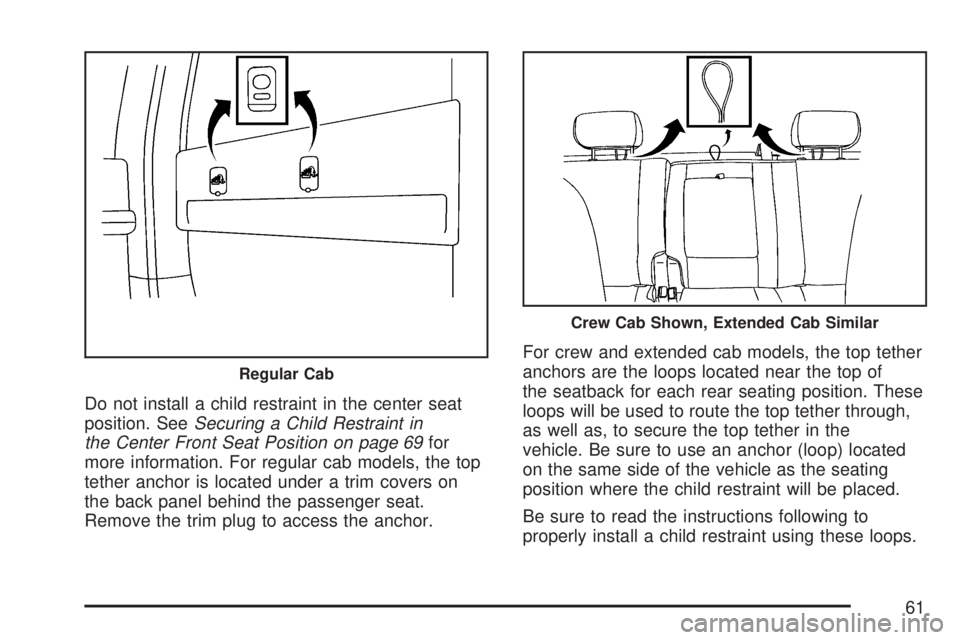
Do not install a child restraint in the center seat
position. SeeSecuring a Child Restraint in
the Center Front Seat Position on page 69for
more information. For regular cab models, the top
tether anchor is located under a trim covers on
the back panel behind the passenger seat.
Remove the trim plug to access the anchor.For crew and extended cab models, the top tether
anchors are the loops located near the top of
the seatback for each rear seating position. These
loops will be used to route the top tether through,
as well as, to secure the top tether in the
vehicle. Be sure to use an anchor (loop) located
on the same side of the vehicle as the seating
position where the child restraint will be placed.
Be sure to read the instructions following to
properly install a child restraint using these loops.
Regular Cab
Crew Cab Shown, Extended Cab Similar
61
Page 62 of 680
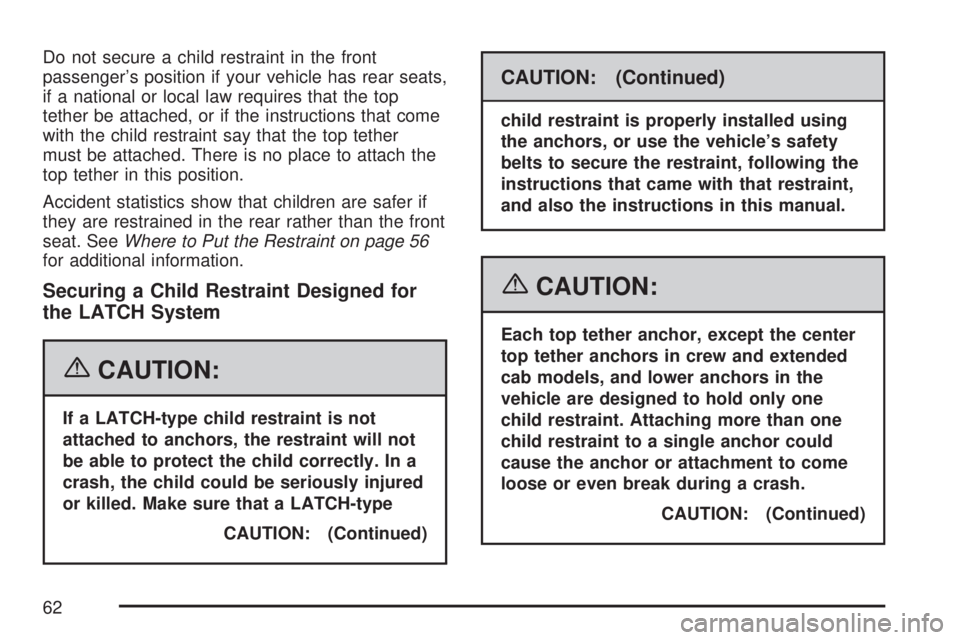
Do not secure a child restraint in the front
passenger’s position if your vehicle has rear seats,
if a national or local law requires that the top
tether be attached, or if the instructions that come
with the child restraint say that the top tether
must be attached. There is no place to attach the
top tether in this position.
Accident statistics show that children are safer if
they are restrained in the rear rather than the front
seat. SeeWhere to Put the Restraint on page 56
for additional information.
Securing a Child Restraint Designed for
the LATCH System
{CAUTION:
If a LATCH-type child restraint is not
attached to anchors, the restraint will not
be able to protect the child correctly. In a
crash, the child could be seriously injured
or killed. Make sure that a LATCH-type
CAUTION: (Continued)
CAUTION: (Continued)
child restraint is properly installed using
the anchors, or use the vehicle’s safety
belts to secure the restraint, following the
instructions that came with that restraint,
and also the instructions in this manual.
{CAUTION:
Each top tether anchor, except the center
top tether anchors in crew and extended
cab models, and lower anchors in the
vehicle are designed to hold only one
child restraint. Attaching more than one
child restraint to a single anchor could
cause the anchor or attachment to come
loose or even break during a crash.
CAUTION: (Continued)
62
Page 63 of 680
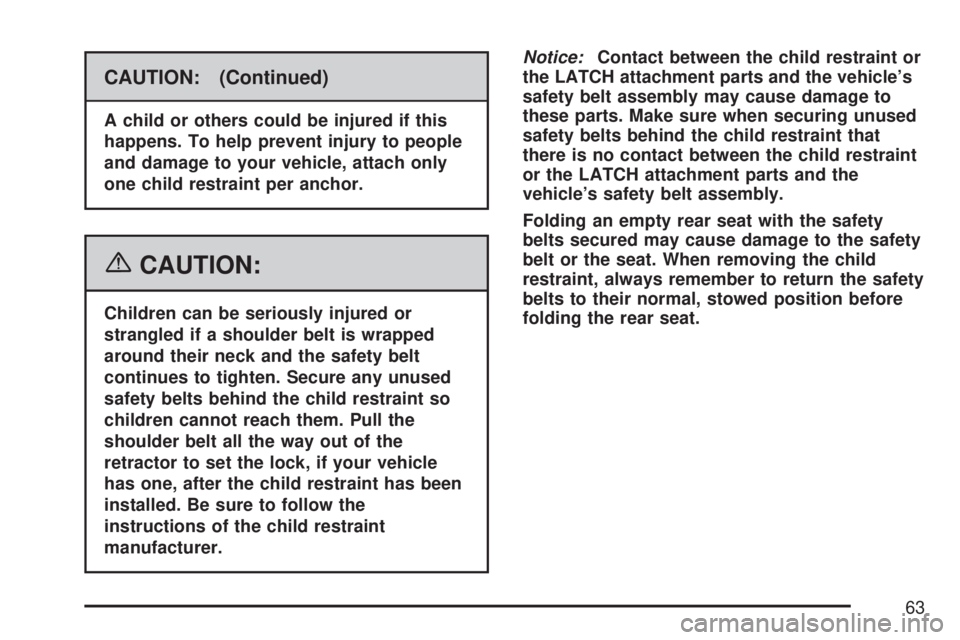
CAUTION: (Continued)
A child or others could be injured if this
happens. To help prevent injury to people
and damage to your vehicle, attach only
one child restraint per anchor.
{CAUTION:
Children can be seriously injured or
strangled if a shoulder belt is wrapped
around their neck and the safety belt
continues to tighten. Secure any unused
safety belts behind the child restraint so
children cannot reach them. Pull the
shoulder belt all the way out of the
retractor to set the lock, if your vehicle
has one, after the child restraint has been
installed. Be sure to follow the
instructions of the child restraint
manufacturer.Notice:Contact between the child restraint or
the LATCH attachment parts and the vehicle’s
safety belt assembly may cause damage to
these parts. Make sure when securing unused
safety belts behind the child restraint that
there is no contact between the child restraint
or the LATCH attachment parts and the
vehicle’s safety belt assembly.
Folding an empty rear seat with the safety
belts secured may cause damage to the safety
belt or the seat. When removing the child
restraint, always remember to return the safety
belts to their normal, stowed position before
folding the rear seat.
63
Page 64 of 680
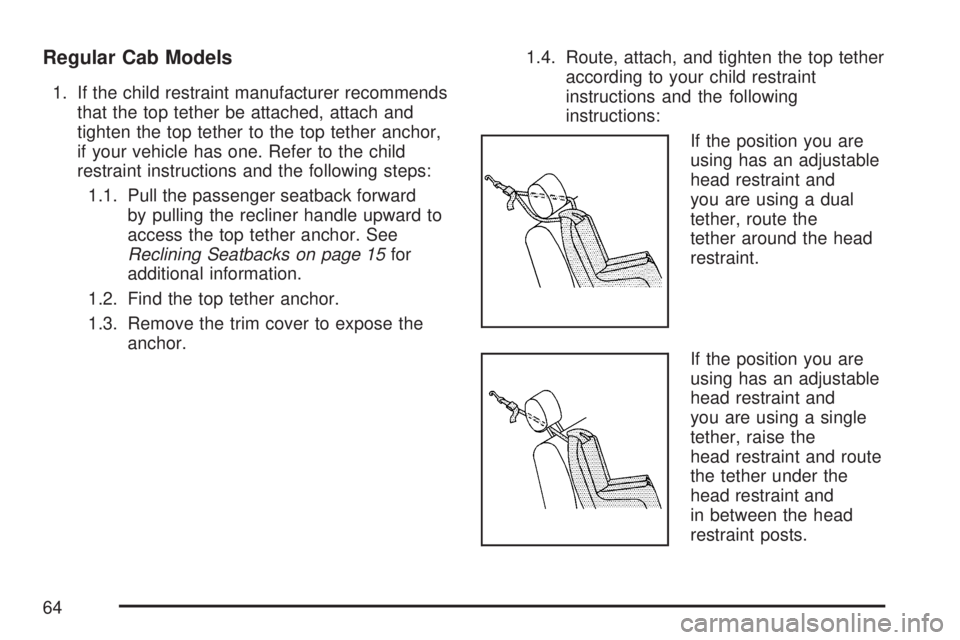
Regular Cab Models
1. If the child restraint manufacturer recommends
that the top tether be attached, attach and
tighten the top tether to the top tether anchor,
if your vehicle has one. Refer to the child
restraint instructions and the following steps:
1.1. Pull the passenger seatback forward
by pulling the recliner handle upward to
access the top tether anchor. See
Reclining Seatbacks on page 15for
additional information.
1.2. Find the top tether anchor.
1.3. Remove the trim cover to expose the
anchor.1.4. Route, attach, and tighten the top tether
according to your child restraint
instructions and the following
instructions:
If the position you are
using has an adjustable
head restraint and
you are using a dual
tether, route the
tether around the head
restraint.
If the position you are
using has an adjustable
head restraint and
you are using a single
tether, raise the
head restraint and route
the tether under the
head restraint and
in between the head
restraint posts.
64
Page 65 of 680
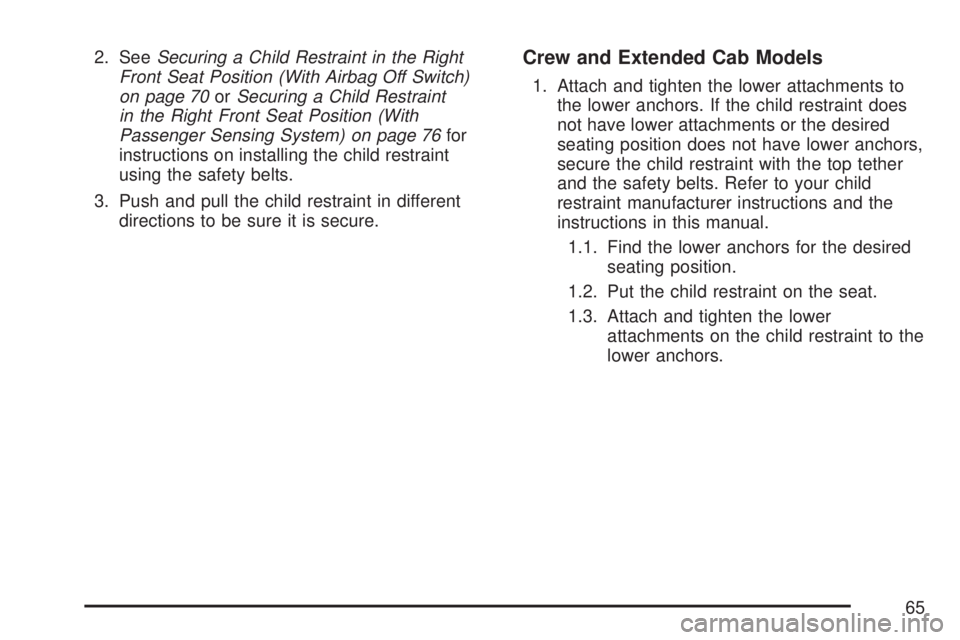
2. SeeSecuring a Child Restraint in the Right
Front Seat Position (With Airbag Off Switch)
on page 70orSecuring a Child Restraint
in the Right Front Seat Position (With
Passenger Sensing System) on page 76for
instructions on installing the child restraint
using the safety belts.
3. Push and pull the child restraint in different
directions to be sure it is secure.Crew and Extended Cab Models
1. Attach and tighten the lower attachments to
the lower anchors. If the child restraint does
not have lower attachments or the desired
seating position does not have lower anchors,
secure the child restraint with the top tether
and the safety belts. Refer to your child
restraint manufacturer instructions and the
instructions in this manual.
1.1. Find the lower anchors for the desired
seating position.
1.2. Put the child restraint on the seat.
1.3. Attach and tighten the lower
attachments on the child restraint to the
lower anchors.
65
Page 66 of 680
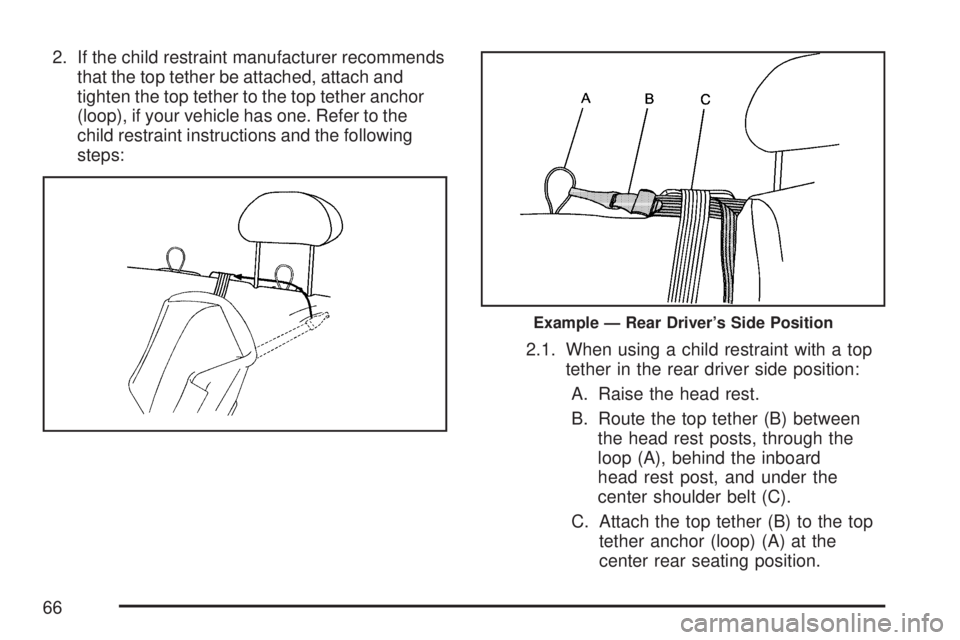
2. If the child restraint manufacturer recommends
that the top tether be attached, attach and
tighten the top tether to the top tether anchor
(loop), if your vehicle has one. Refer to the
child restraint instructions and the following
steps:
2.1. When using a child restraint with a top
tether in the rear driver side position:
A. Raise the head rest.
B. Route the top tether (B) between
the head rest posts, through the
loop (A), behind the inboard
head rest post, and under the
center shoulder belt (C).
C. Attach the top tether (B) to the top
tether anchor (loop) (A) at the
center rear seating position.
Example — Rear Driver’s Side Position
66
Page 67 of 680
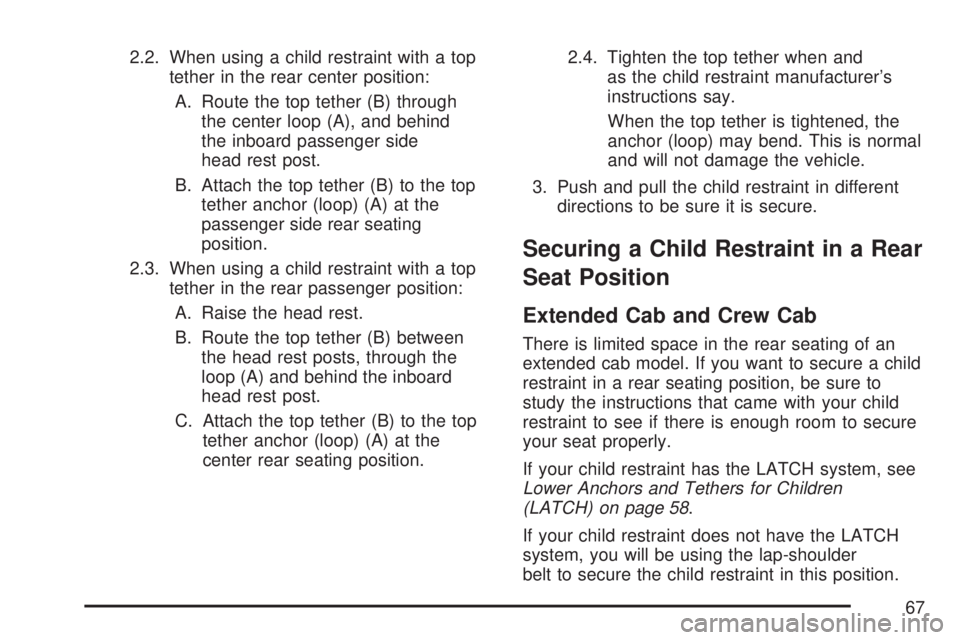
2.2. When using a child restraint with a top
tether in the rear center position:
A. Route the top tether (B) through
the center loop (A), and behind
the inboard passenger side
head rest post.
B. Attach the top tether (B) to the top
tether anchor (loop) (A) at the
passenger side rear seating
position.
2.3. When using a child restraint with a top
tether in the rear passenger position:
A. Raise the head rest.
B. Route the top tether (B) between
the head rest posts, through the
loop (A) and behind the inboard
head rest post.
C. Attach the top tether (B) to the top
tether anchor (loop) (A) at the
center rear seating position.2.4. Tighten the top tether when and
as the child restraint manufacturer’s
instructions say.
When the top tether is tightened, the
anchor (loop) may bend. This is normal
and will not damage the vehicle.
3. Push and pull the child restraint in different
directions to be sure it is secure.
Securing a Child Restraint in a Rear
Seat Position
Extended Cab and Crew Cab
There is limited space in the rear seating of an
extended cab model. If you want to secure a child
restraint in a rear seating position, be sure to
study the instructions that came with your child
restraint to see if there is enough room to secure
your seat properly.
If your child restraint has the LATCH system, see
Lower Anchors and Tethers for Children
(LATCH) on page 58.
If your child restraint does not have the LATCH
system, you will be using the lap-shoulder
belt to secure the child restraint in this position.
67
Page 68 of 680
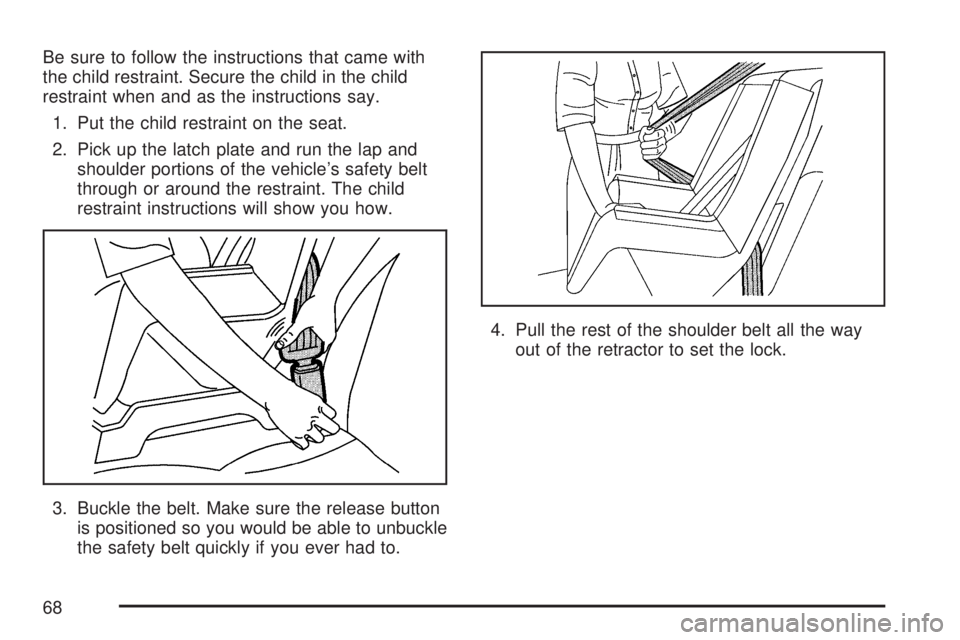
Be sure to follow the instructions that came with
the child restraint. Secure the child in the child
restraint when and as the instructions say.
1. Put the child restraint on the seat.
2. Pick up the latch plate and run the lap and
shoulder portions of the vehicle’s safety belt
through or around the restraint. The child
restraint instructions will show you how.
3. Buckle the belt. Make sure the release button
is positioned so you would be able to unbuckle
the safety belt quickly if you ever had to.4. Pull the rest of the shoulder belt all the way
out of the retractor to set the lock.
68
Page 69 of 680
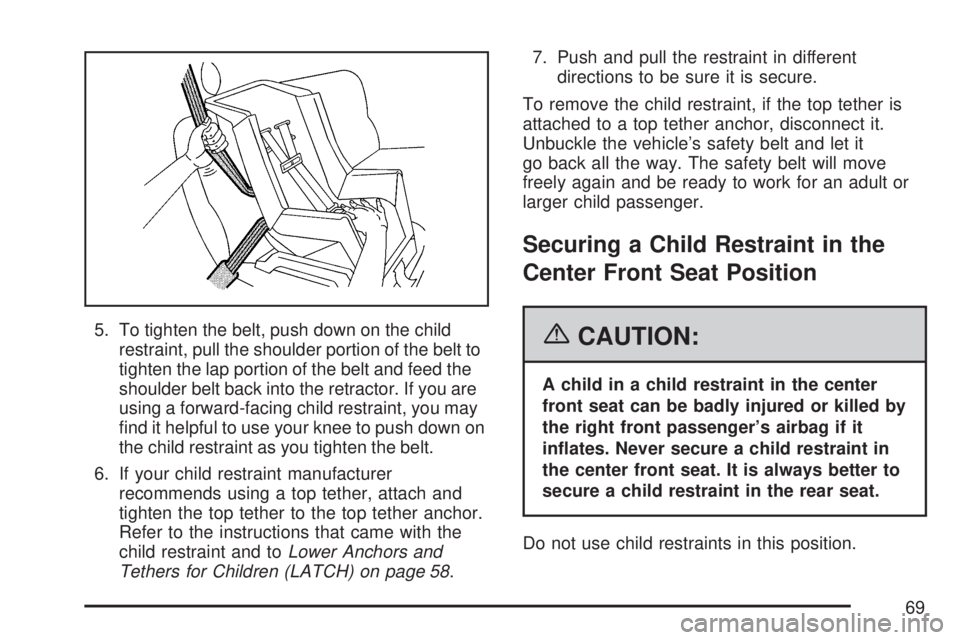
5. To tighten the belt, push down on the child
restraint, pull the shoulder portion of the belt to
tighten the lap portion of the belt and feed the
shoulder belt back into the retractor. If you are
using a forward-facing child restraint, you may
�nd it helpful to use your knee to push down on
the child restraint as you tighten the belt.
6. If your child restraint manufacturer
recommends using a top tether, attach and
tighten the top tether to the top tether anchor.
Refer to the instructions that came with the
child restraint and toLower Anchors and
Tethers for Children (LATCH) on page 58.7. Push and pull the restraint in different
directions to be sure it is secure.
To remove the child restraint, if the top tether is
attached to a top tether anchor, disconnect it.
Unbuckle the vehicle’s safety belt and let it
go back all the way. The safety belt will move
freely again and be ready to work for an adult or
larger child passenger.
Securing a Child Restraint in the
Center Front Seat Position
{CAUTION:
A child in a child restraint in the center
front seat can be badly injured or killed by
the right front passenger’s airbag if it
in�ates. Never secure a child restraint in
the center front seat. It is always better to
secure a child restraint in the rear seat.
Do not use child restraints in this position.
69
Page 70 of 680
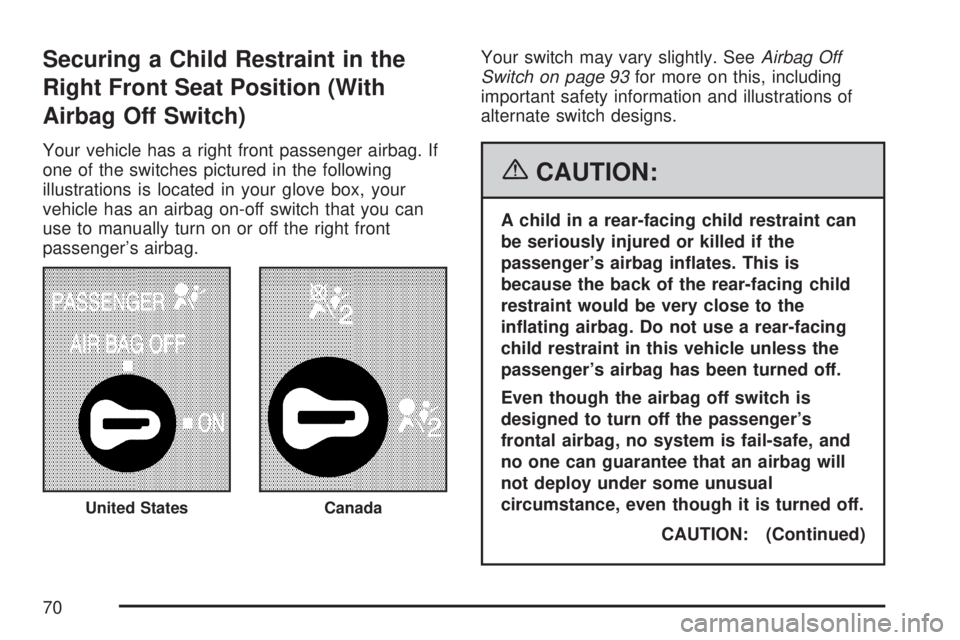
Securing a Child Restraint in the
Right Front Seat Position (With
Airbag Off Switch)
Your vehicle has a right front passenger airbag. If
one of the switches pictured in the following
illustrations is located in your glove box, your
vehicle has an airbag on-off switch that you can
use to manually turn on or off the right front
passenger’s airbag.Your switch may vary slightly. SeeAirbag Off
Switch on page 93for more on this, including
important safety information and illustrations of
alternate switch designs.
{CAUTION:
A child in a rear-facing child restraint can
be seriously injured or killed if the
passenger’s airbag in�ates. This is
because the back of the rear-facing child
restraint would be very close to the
in�ating airbag. Do not use a rear-facing
child restraint in this vehicle unless the
passenger’s airbag has been turned off.
Even though the airbag off switch is
designed to turn off the passenger’s
frontal airbag, no system is fail-safe, and
no one can guarantee that an airbag will
not deploy under some unusual
circumstance, even though it is turned off.
CAUTION: (Continued)
United StatesCanada
70